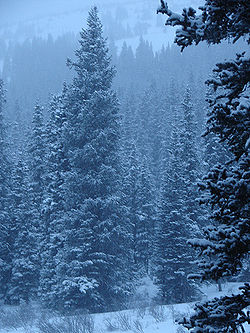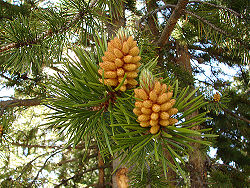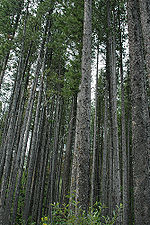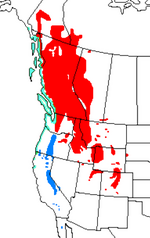Lodgepole pine
The Lodgepole pine is a species of pine tree that has four varieties. The Lodgepole pine's cones need extreme heat to open and release the seeds. This tree is very helpful to the environment; many small mammals use the inner bark of the tree for their food. [1]
Anatomy
The Lodgepole pine is a Evergreen tree and usually grows to seventy feet high and about twenty-four inches around. This tree is usually known for its small trunk and very high, tiny crown. [2] The bark is like a usual tree with its coloring being one of a reddish brown to gray. [3]The twigs on the stem of the tree are covered with leaves that can stay on the stem up to five years. You can find both the male and female cone on the same tree but you will not find them together. The male cones are larger then the female ones.
Reproduction
The Lodgepole pine has the same reproduction as most pines have. It can as long as twenty-six months. The pollen cones will first start in summer but become dormant over the winter season. The pollen will end up forming in the early spring. You will then start to see the lateral buds form into long shoots or seed cones pop up in the late summer. You will finally see both buds differentiate each other the next spring. The pollination will then begin in late May/June. The pollination year the female cones start to develop but become dormant in July/August. It starts back up in April and the sperm and eggs are formed by June which is when the fertilization occurs. [4] In vegetative reproduction the pines can be grafted but you will see the results will vary depending on the clone you choose to use. [5]
Ecology
The Lodgepole pine obviously grows in forest's. Which is what makes it so common to the Northwest. The Rocky Mountains are just one of many areas that the pine grows abundance in. It covers about 15 million acres in the United States and around 50 mil. acres in Canada. The Lodgepole pine grows best in the sunlight and does not like the shade very much. It grows best in moist soil, the Lodgepole pine is one of the most tolerable trees in North America, seeing how it can grow pretty much anywhere. [6]
Mountain Pine Beetles
The mountain beetles form and make their homes in pine particular the lodgepole pine. These bugs will infest the wood and are often not helpful and usually end up killing the tree. [7] What will happen is the beetle will infest the wood slowly killing it and once the needles are red it means two things. The red needles indicate the tree is dead and extremely flammable, which means it could easily catch a spark or something and start a horrible forest fire. [8]
Gallery
References
- link title Author. Publisher. Date
- link title Author. Publisher. Date
- link title Author. Publisher. Date





